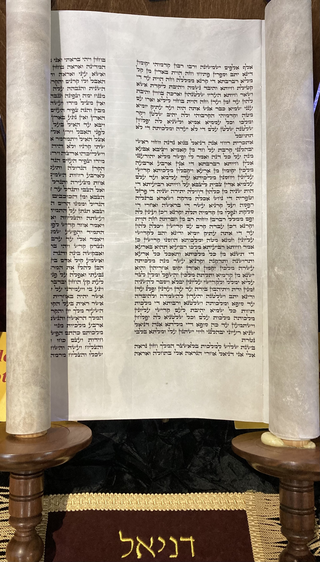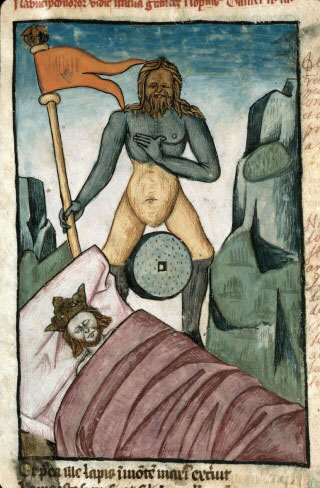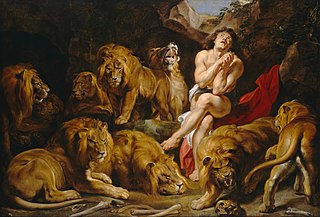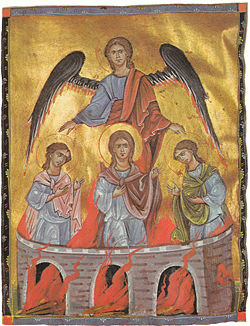
The Book of Daniel is a biblical apocalypse authored during the 2nd century BC and set during the 6th century BC. Ostensibly "an account of the activities and visions of Daniel, a noble Jew exiled at Babylon", the text features a prophecy rooted in Jewish history, as well as a portrayal of the end times that is both cosmic in scope and political in its focus. The message of the text intended for the original audience, was that just as the God of Israel saves Daniel from his enemies, so he would save the Israelites in their present oppression.
The oldest surviving Hebrew Bible manuscripts, the Dead Sea Scrolls, date to c. the 2nd century BCE. Some of these scrolls are presently stored at the Shrine of the Book in Jerusalem. The oldest text of the entire Christian Bible, including the New Testament, is the Codex Sinaiticus dating from the 4th century CE, with its Old Testament a copy of a Greek translation known as the Septuagint. The oldest extant manuscripts of the vocalized Masoretic Text date to the 9th century CE. With the exception of a few biblical sections in the Nevi'im, virtually no biblical text is contemporaneous with the events it describes.

The Prayer of Azariah and Song of the Three Holy Children, abbreviated Pr Azar, is a passage which appears after Daniel 3:23 in some translations of the Bible, including the ancient Greek Septuagint translation.

Belshazzar's feast, or the story of the writing on the wall, chapter 5 in the Book of Daniel, tells how Belshazzar holds a great feast and drinks from the vessels that had been looted in the destruction of the First Temple. A hand appears and writes on the wall. The terrified Belshazzar calls for his wise men, but they are unable to read the writing. The queen advises him to send for Daniel, renowned for his wisdom. Daniel reminds Belshazzar that his father Nebuchadnezzar, when he became arrogant, was thrown down until he learned that God has sovereignty over the kingdom of men. Belshazzar had likewise blasphemed God, and so God sent this hand. Daniel then reads the message and interprets it: God has numbered Belshazzar's days, he has been weighed and found wanting, and his kingdom will be given to the Medes and the Persians.
That very night Belshazzar, the Chaldean [Babylonian] king, was killed. And Darius the Mede received the kingdom […]

The Burning Fiery Furnace is an English music drama with music composed by Benjamin Britten, his Opus 77, to a libretto by William Plomer. One of Britten's three Parables for Church Performances, this work received its premiere at the St Bartholomew's Church, Orford, Suffolk, England, on 9 June 1966 by the English Opera Group.

Darius the Mede is mentioned in the Book of Daniel as King of Babylon between Belshazzar and Cyrus the Great, but he is not known to secular history and there is no space in the historical timeline between those two verified rulers. Belshazzar, who is often mentioned as king in the book of Daniël, was in fact the crown-prince and governer while his father was in Arabia from ca. 553 tot 543 BCE, but Nabonidus had returned to Babylon years before the fall of the Babylonian empire.

Daniel 2 tells how Daniel related and interpreted a dream of Nebuchadnezzar II, king of Babylon. In his night dream, the king saw a gigantic statue made of four metals, from its head of gold to its feet of mingled iron and clay; as he watched, a stone "not cut by human hands" destroyed the statue and became a mountain filling the whole world. Daniel explained to the king that the statue represented four successive kingdoms beginning with Babylon, while the stone and mountain signified a kingdom established by God which would never be destroyed nor given to another people. Nebuchadnezzar then acknowledges the supremacy of Daniel's God and raises him to high office in Babylon.
The additions to Daniel are three chapters not found in the Hebrew/Aramaic text of Daniel. The text of these chapters is found in the Septuagint, the earliest extant Greek translation of the Hebrew Bible from the original Hebrew.

"Shadrach" is a song by American hip hop group Beastie Boys from their second studio album Paul's Boutique (1989). It was released as the album's second single on October 30, 1989, as a 7-inch vinyl backed with the non-album track "And What You Give Is What You Get". Both songs appear on the EP An Exciting Evening at Home with Shadrach, Meshach and Abednego (1989).
Daniel 7 tells of Daniel's vision of four world-kingdoms replaced by the kingdom of the saints or "holy ones" of the Most High, which will endure for ever. Four beasts come out of the sea, the Ancient of Days sits in judgment over them, and "one like a son of man" is given eternal kingship. An angelic guide interprets the beasts as kingdoms and kings, the last of whom will make war on the "holy ones" of God, but they will be destroyed and the "holy ones" will be given eternal dominion and power.
Daniel 8 is the eighth chapter of the Book of Daniel. It tells of Daniel's vision of a two-horned ram destroyed by a one-horned goat, followed by the history of the "little horn", which is Daniel's code-word for the Greek king Antiochus IV Epiphanes.

Allusions in rabbinic literature to the Biblical story of Daniel contain various expansions, elaborations and inferences beyond the text presented in the Book of Daniel. These stories are describing Jewish success in the Diaspora, where it was important to emphasize Jewish wisdom and statecraft during periods of foreign domination in order to strengthen the sense of worth and ethnic pride of the Jewish people.

Daniel is an anonymous Old English poem based loosely on the Biblical Book of Daniel, found in the Junius Manuscript. The author and the date of Daniel are unknown. Critics have argued that Cædmon is the author of the poem, but this theory has been since disproven. Daniel, as it is preserved, is 764 lines long. There have been numerous arguments that there was originally more to this poem than survives today. The majority of scholars, however, dismiss these arguments with the evidence that the text finishes at the bottom of a page, and that there is a simple point, which translators assume indicates the end of a complete sentence. Daniel contains a plethora of lines which Old English scholars refer to as “hypermetric” or long.

Daniel is the main character of the Book of Daniel. According to the Hebrew Bible, Daniel was a noble Jewish youth of Jerusalem taken into captivity by Nebuchadnezzar II of Babylon, serving the king and his successors with loyalty and ability until the time of the Persian conqueror Cyrus, all the while remaining true to the God of Israel. While some conservative scholars hold that Daniel existed and his book was written in the 6th century BCE, most scholars agree that Daniel is not a historical figure and that much of the book is a cryptic allusion to the reign of the 2nd century BCE Hellenistic king Antiochus IV Epiphanes.
Chapters 10, 11, and 12 in the Book of Daniel make up Daniel's final vision, describing a series of conflicts between the unnamed "King of the North" and "King of the South" leading to the "time of the end", when Israel will be vindicated and the dead raised, some to everlasting life and some to shame and everlasting contempt.

Daniel in the lions' den tells of how the biblical Daniel is saved from lions by the God of Israel "because I was found blameless before him". It parallels and complements chapter 3, the story of Shadrach, Meshach, and Abednego: each begins with the jealousy of non-Jews towards successful Jews and an imperial edict requiring them to compromise their religion, and concludes with divine deliverance and a king who confesses the greatness of the God of the Jews and issues an edict of royal protection. The tales making up chapters 1–6 of Daniel date no earlier than the Hellenistic period and were probably originally independent, but were collected in the mid-2nd century BC and expanded shortly afterwards with the visions of the later chapters to produce the modern book.

Daniel 1 tells how Daniel and his three companions were among captives taken by Nebuchadnezzar II from Jerusalem to Babylon to be trained in Babylonian wisdom. There they refused to take food and wine from the king and were given knowledge and insight into dreams and visions by God, and at the end of their training they proved ten times better than all the magicians and enchanters in the kingdom.

Daniel 4, the fourth chapter of the Bible's Book of Daniel, is presented in the form of a letter from king Nebuchadnezzar II in which he learns a lesson of God's sovereignty, "who is able to bring low those who walk in pride". Nebuchadnezzar dreams of a great tree that shelters the whole world, but an angelic "watcher" appears and decrees that the tree must be cut down and that for seven years, he will have his human mind taken away and will eat grass like an ox. This comes to pass, and at the end of his punishment, Nebuchadnezzar praises God. Daniel's role is to interpret the dream for the king.

An Exciting Evening at Home with Shadrach, Meshach and Abednego is an EP by rap trio Beastie Boys. It was released on October 30, 1989.

The Acts of Mar Mari [ܦܪܲܟܣܝ̣ܣ ܕܡܳܪܝ ܡܳܐܪܝ̣] is a Syriac Christian apocryphal acts. It pertains to the introduction of Christianity in northern and southern Mesopotamia by Addai's disciple Saint Mari in the first century and in the beginning of the second century AD.



















